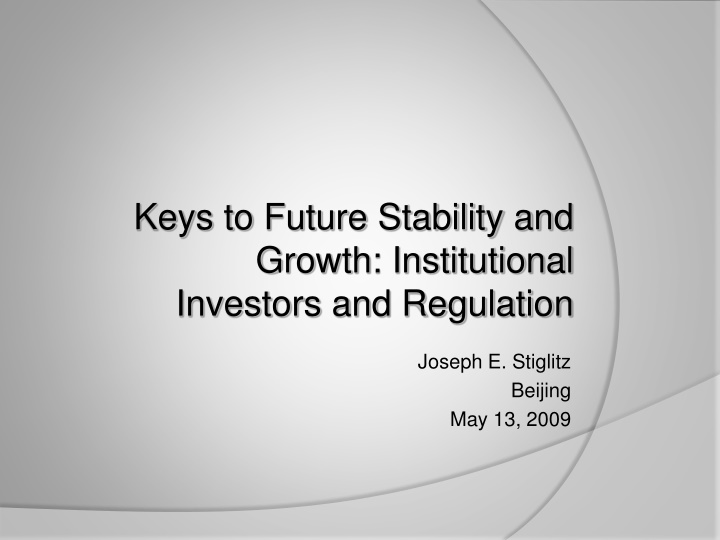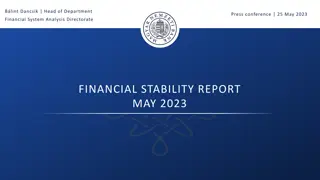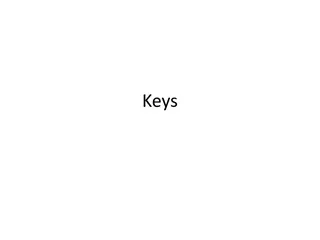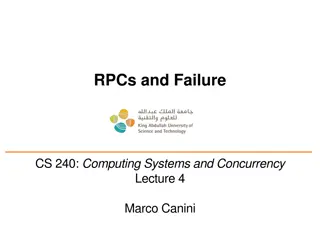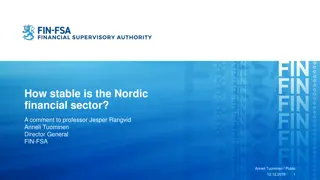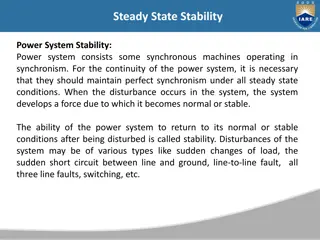Keys to Future Stability and Growth: Lessons and Failures
The content explores the lessons learned and failures of the current financial crisis, focusing on institutional investors, regulatory frameworks, and the shortcomings of America's financial system. It delves into incentives, transparency, competition, and the need for a new regulatory structure to address information imperfections and behavioral economics.
Download Presentation

Please find below an Image/Link to download the presentation.
The content on the website is provided AS IS for your information and personal use only. It may not be sold, licensed, or shared on other websites without obtaining consent from the author.If you encounter any issues during the download, it is possible that the publisher has removed the file from their server.
You are allowed to download the files provided on this website for personal or commercial use, subject to the condition that they are used lawfully. All files are the property of their respective owners.
The content on the website is provided AS IS for your information and personal use only. It may not be sold, licensed, or shared on other websites without obtaining consent from the author.
E N D
Presentation Transcript
Keys to Future Stability and Growth: Institutional Investors and Regulation Joseph E. Stiglitz Beijing May 13, 2009
Outline Some basic concepts/lessons from the Some basic concepts/lessons from the current crisis current crisis Traditional roles of institutional investors and asset managers New roles of asset management in the new regulatory framework?
The current crisis and where the system failed Incentives Market participants had incentives to engage in excessive risk taking/short sighted behavior Conflicts of interest Transparency Market participants had incentives and instruments for non-transparency But failure was more than that of transparency: complexity Competition Too big to fail institutions had incentives to engage in excessive risk taking Competition didn t work race to the bottom
Failures of Americas Financial System Didn t manage risk created risk Misallocated capital Too much into housing, too little to real investment, innovative sector, improving environment High transaction costs Resisted creation of an efficient electronic transfer system Predatory lending practices
Failures of Americas Financial System Innovations directed at regulatory, accounting, and tax arbitrage Little innovation at meeting society s real needs Failed at both micro and macro level Major social problems devastation of the poor in America Global macro-problem
Model didnt work Self-regulation didn t work Perverse incentives Self-regulation can t work externalities Model of risk diversification (securitization) didn t work Increased information asymmetries Systems of market checks and balances failed (credit rating agencies) Regulatory checks and balances failed Ideology Ideology Capture Capture
What are the key factors in the design of a new regulatory structure and system ? Asymmetries and imperfections of information Moral hazard Human fallibility/ behavioral economics Externalities
Key features of new regulatory system Regulation has to be comprehensive Globally, domestically Products, Institutions Restrictions on incentives Restrictions on size Restrictions on risk taking Transparency/complexity Financial product safety commission
Key principles to be safeguarded/ put in place Mark-to-market best information available Care in regulatory use of information Care in design of mark to market system Restrict or inhibit the use of over-the- counter derivatives Restrictions on leverage, countercyclical provisioning/capital adequacy Have the voice of those whose interests are likely to be hurt be well represented in the regulatory structure
A good regulatory system can contribute to a more dynamic, innovative economy, a more efficient economy, a more stable economy, and a more harmonious society Can t return to the world as it was before the crisis
Outline Some basic concepts/lessons from the current crisis Traditional roles of institutional investors Traditional roles of institutional investors and asset managers and asset managers New roles of asset management in the new regulatory framework?
A distinctive feature of this financial crisis versus previous ones It has occurred in highly securitized and institutionalized context Theory was that risk would be spread/diversification would Theory was that risk would be spread/diversification would make economy more stable make economy more stable Banks didn t move as much risk off their balance sheet as Banks didn t move as much risk off their balance sheet as they pretended they pretended Securitization worsened problems of information asymmetry Securitization worsened problems of information asymmetry Securitization worsened problems of ex post resolution Securitization worsened problems of ex post resolution Increasingly important role of institutional investors Pension funds Pension funds Life insurance Life insurance Mutual funds Mutual funds Sovereign and other government Sovereign and other government- -sponsored funds sponsored funds
Household and Sovereign portfolios The flip-side of securitization Securities are increasingly held by households, either directly or indirectly through institutional investors Pension funds and life insurance mean an increasing number of households access securities markets Recently sovereign funds and other government- sponsored funds have gained increasing relevance and become important investors
Households are, to varying degrees, exposed to securities and to institutional investors 70% Share of institutional investors 60% Netherlands 50% UK 40% Germany US Austria France 30% Japan 20% Spain Italy 10% 40% 50% Securities in household portfolios (%) 60% 70% 80% 90% The degree of institutionalization refers to the share of family financial assets in pension funds, life insurance policies and mutual funds, which e usually considered institutional investors. With the term securitization, we refer to the transferability of the assets in the financial market, and specifically all financial products excluding deposits. Source: PGAM Research elaboration on Central bank statistics
The effect of the current crisis on household financial wealth has been dramatic In terms of net wealth/GDP, the crisis has brought us below the 1995 levels and significantly so for the UK. which seems to have missed most of the equity market rebound after 2003 and also to have suffered more in the downturn Household financial wealth: net fin. wealth/GDP ratio (nominal data) 300% USA Emu Italy UK 260% 220% 180% 140% source: Fed, Banca d'talia, BCE, ONS 100% 1995 1996 1997 1998 1999 2000 2001 2002 2003 2004 2005 2006 2007 2008 USA: Flow of funds figures as of December 2008, Italy, UK : National accounts data as of 3rdquarter 2008, PGAM Research estimates for fourth quarter
Outline Some basic concepts/lessons from the current crisis Traditional roles of institutional investors and asset managers New roles of asset management in the New roles of asset management in the new regulatory framework? new regulatory framework?
Challenges facing institutional investing Securitization, for all the virtues of diversification, has introduced new asymmetries of information Some institutional investors also act in short sighted manner, exhibiting herding behavior Increased reliance on 3rdparty valuations power of credit rating agencies
The new regulatory framework What institutional investors want Institutional investors interests coincide broadly with social objectives of a good regulatory system Marginalize over-the-counter transactions Increased transparency, lower transactions costs, better risk Increased transparency, lower transactions costs, better risk management management at a slight loss of ability to tailor products at a slight loss of ability to tailor products Use exchanges that are also hubs for full information on the origin and evolution of securities, reduce scope for counterparty risk, reduce scope for hidden leverage Enforce high levels of product standardization and transparency in transactions/pricing
The new regulatory framework What institutional investors can offer Portfolio diversification Continuous monitoring of securities in the portfolios through fundamental analysis Mark-to-market and mark-to-maturity
The new regulatory framework What should institutional investors look like With independent governance, independence from sell side : reduce scope for conflicts of interests Main mandate: avoid potential negative impacts of information asymmetries on final investors (households/governments) Provide effective diversification Low transactions costs Offer simple and understandable default solutions
The new regulatory framework How institutional investors would fit in a 21st How institutional investors would fit in a 21st Century Regulatory Framework Century Regulatory Framework A good alternative to the too big to fail institutions- they basically decentralize risk Have limited or non-existent leverage Appropriate to represent a vast array of final interests (employees, retirees, governments, plan sponsors) Help think through appropriate risk analysis Help improve corporate governance? Have a culture of transparency
Rethinking our Financial System America s financial system failed at great cost to America and the world It is important for America and all other countries to learn the right lessons Securitization can/will be an important part of 21stcentury financial markets But for securitization to work, there has be much better regulations of all aspects of the financial market
Rethinking our Financial System With appropriate regulatory structures, institutional investors can play an important role in enhancing the ability of ordinary citizens to manage the risks they face And can contribute to a more efficient and stable economy
